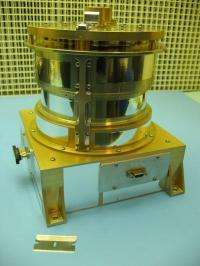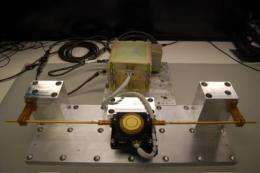FASTSAT instruments shipped for tests and launch preparation

Three of the satellite instruments that will fly on an upcoming satellite mission called "FASTSAT" have been created at one NASA center and have arrived at another for more tests to ensure they are flight ready for launch. They're now at the Marshall Space Flight Center in Huntsville, Ala. for further testing.
"FASTSAT" means "Fast, Affordable, Science and Technology Satellite." The development, integration, test and operations of the three instruments is a collaborative effort between NASA's Goddard Space Flight Center in Greenbelt, Md., NASA's Marshall Space Flight Center in Huntsville, Ala., and the U.S. Naval Academy (USNA) in Annapolis, Md.
FASTSAT will be flying a total of six instruments approved by the U.S. Department of Defense (DoD) Science and Experiments Review Board multi-spacecraft/payload mission named STP-S26, which is executed by the DoD Space Test Program (STP) at the Space Development and Test Wing (SDTW), Kirtland Air Force Base, N.M. which is a unit of the Air Force Space and Missile Systems Center. The mission was designated S26 to correspond to the 26th small launch vehicle mission in STP's 40+year history of flying DoD space experiments. The mission will launch four satellites and three cubesats into low earth orbit.
The three instruments that will fly on FASTSAT were built at NASA Goddard and already went through some tests. They were in a vacuum chamber that simulated the vacuum of space. The instruments include the TTI, or Thermosphere Temperature Imager that will make measurements for things like spacecraft drag; the Mini-ME, a low energy neutral atom imager which will detect neutral atoms formed in the plasma population of the Earth's outer atmosphere to improve global space weather prediction; and PISA, the Plasma and Impedence Spectrum Analyzer which will test a new measurement technique for the thermal electron populations in the ionosphere, and their density structuring, which can interfere with or scatter radio signals used for communication and navigation.

The instruments are part of long standing partnership between Goddard and the USNA. Naval Academy Midshipmen have assisted with development and systems integration of instruments, and will be involved in the payload commanding and data analysis.
Past activities involved instrument spacecraft integration including vibration testing and analysis of instrument data including analysis of theoretical instrument response. These activities complement the USNA's engineering and science curriculum. "This continues educational outreach activities between Goddard and the Academy spanning 15 years and builds on NASA experience with the Academy's MidSTAR-1 satellite in which several NASA experiments successfully flew," said Commander David Myre of Aerospace Engineering Dept. at the USNA.
The Thermospheric Temperature Imager, or TTI and it will provide the first global-scale measurements of thermospheric temperature profiles in the 200-400 km (124-248 miles) region. The temperature profile sets the scale height of the thermosphere which determines the density at orbital altitudes and therefore the aerodynamic drag experienced by military spacecraft.
"The MINI-ME instrument is a low energy neutral atom imager. Low energy neutral atom imaging is a technique first pioneered at Goddard, that allows scientists to observe remotely various trapped charged particle populations around Earth that we would normally only be able to observe in-situ - or exactly where an instrument is," said Michael Collier, Principal Investigator at NASA Goddard. "It's an improvement on the same kind of instrument, LENA that flew on the IMAGE mission. Measurements made by instruments like MINI-ME will enable more accurate prediction of space weather."
PISA is the third instrument on FASTSAT. Principal Investigator Doug Rowland at NASA Goddard said that "PISA will determine when and where the ionosphere becomes structured or turbulent, permitting better predictive models of space weather effects on GPS signals."
Collier said "Although the three instruments are stand-alone experiments, the FASTSAT project currently plans at times to operate all three instruments simultaneously in flight. This will allow the three Goddard investigators to use the information from the other two instruments to better understand their own data."
"The instruments are a collaborative effort between the Naval Academy and Goddard, allowing midshipmen to work side-by-side with scientists and engineers providing them unique experiences and training for the future Navy Space Cadre," Commander Myre said.
The satellite was created at NASA Marshall with the Von Braun Center for Science and Innovation, in partnership with Dynetics, a corporate partner. "Engineers at NASA Marshall will test TTI, Mini-ME and PISA to ensure they can withstand the vibrations of launch, and the frigid temperatures in space," said FASTSAT Project Manager Mark Boudreaux at NASA Marshall.



















